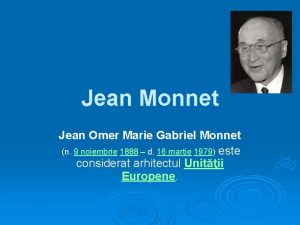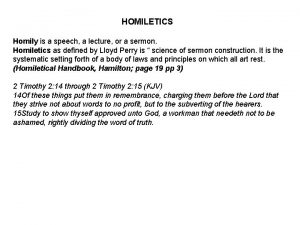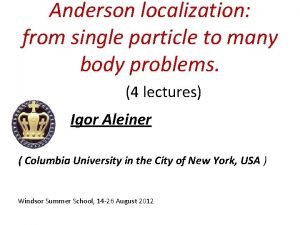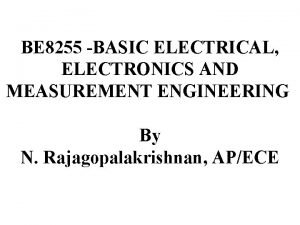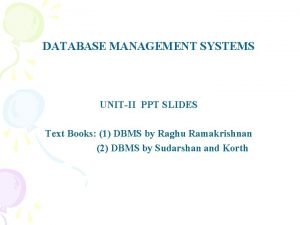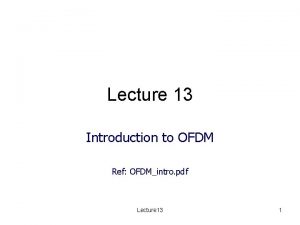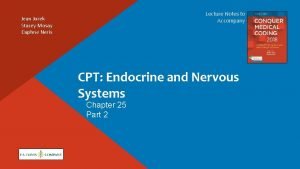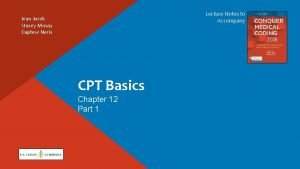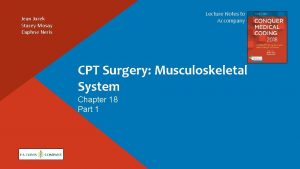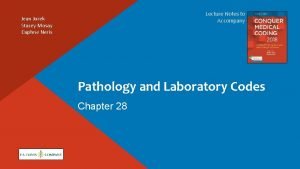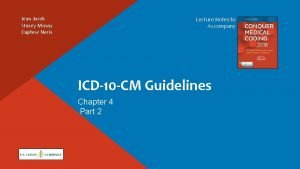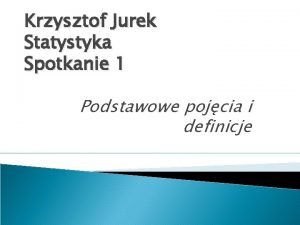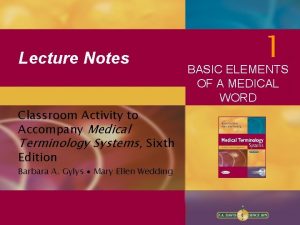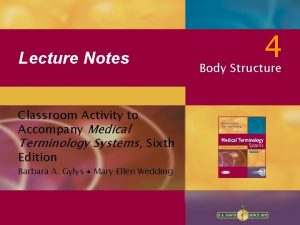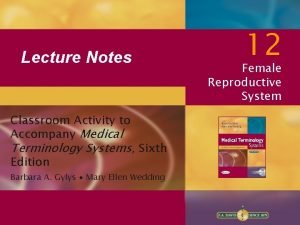Lecture Notes to Accompany Jean Jurek Stacey Mosay





























- Slides: 29

Lecture Notes to Accompany Jean Jurek Stacey Mosay Daphne Neris HCPCS (Healthcare Common Procedure Coding System) Chapter 30 Part 2

Outline HCPCS Code Sections Modifiers Assigning HCPCS Codes Copyright © F. A. Davis 2018 2

Learning Outcomes After completing this presentation, you should be able to: 1. Explain the purpose of the HCPCS code set. 2. Differentiate between HCPCS Level I (CPT) and HCPCS Level II codes. 3. Identify circumstances under which codes from both HCPCS Level I and HCPCS Level II are required. 4. Compare permanent and temporary HCPCS codes. 5. Describe the content and organization of the Index, Table of Drugs, and main text in HCPCS Copyright © F. A. Davis 2018 6. Discuss the sources of information needed to keep current with HCPCS changes. 7. Understand the HCPCS A–V code sections. 8. Describe the purpose and correct usage of HCPCS modifiers, including ABN modifiers. 9. Choose the correct medication code based on the route of administration and the amount of medication administered. 10. Apply rules for choosing which level of HCPCS code to assign. 3

HCPCS Code Sections Copyright © F. A. Davis 2018 4

Section A: Transportation Services (Including Ambulance, Medical, and Surgical Supplies, as Well as Administrative, Miscellaneous, and Investigational) (A 0000–A 9999) Services Ambulance, chiropractic, and medical and surgical supplies Copyright © F. A. Davis 2018 Examples A 0429 Ambulance service, basic life support, emergency transport (BLS, emergency) A 4550 Surgical tray used during minor procedure A 4649 Miscellaneous supplies 5

Section B: Enteral and Parenteral Therapy (B 4000–B 9999) Services Supplies, formulae, nutritional solutions, and infusion pumps Patient requiring tube feedings Enterally Parenterally Through intestine Enter body other than through the digestive tract (e. g. , IV therapy, nasogastric tube) Percutaneous endoscopic gastrostomy tube (PEG) Inserted into patient’s stomach Copyright © F. A. Davis 2018 Examples B 4102 Enteral formula, for adults, used to replace fluids and electrolytes, 500 m. L = 1 unit If medication was given through a feeding tube or parenteral method, an additional J code for the medication should be assigned. 6

Section C: Outpatient Prospective Payment System (PPS ) (C 0000–C 9999) Temporary codes Hospital-based surgery centers and hospital-based outpatient services Not reported by physicians; reported by facilities Used according to Medicare Outpatient Prospective Payment System (OPPS) Most packaged into ambulatory payment classifications (APC) Predetermined payment amounts Example: C 2625 Stent, noncoronary, temporary, with delivery system Copyright © F. A. Davis 2018 7

Codes for ambulance, chiropractic, and medical and surgical supplies are located in section _____. A. A B. B C. D D. E

Section E: Durable Medical Equipment (DME) (E 0100–E 9999) Designated for DME codes may be reported by all providers, regardless of specialty, not just DME supply companies Canes, crutches, hospital beds, pacemakers, and dialysis kidney machines Orthopedic medicine Podiatry Family and general practice Home health Physical therapy Example: E 0148 Walker, heavy duty, without wheels, rigid or folding, any type, each Copyright © F. A. Davis 2018 9

Section G: Procedures and Professional Services (G 0000–G 9999) Guidelines Temporary codes Services being evaluated and reviewed for inclusion in CPT codebook Required and reported in lieu of CPT codes for Medicare patients Codes for procedures and services that do not exactly match a CPT code designation Copyright © F. A. Davis 2018 Examples G 0027 Semen analysis; presence or motility of sperm excluding Huhner Use for Medicare as well as when testing only for presence CPT equivalent code would be 89321 Semen analysis; sperm presence and motility of sperm, if performed. Use when testing for presence as well as mobility 10

Section _____ codes are designated for DME such as canes, crutches, hospital beds, pacemakers, and dialysis kidney machines. A. A B. B C. D D. E

Section H: Alcohol and Drug Abuse Treatment Services (H 0001–H 2037) Section J: Drugs Administered Other Than Oral Method, Chemotherapy (J 0000–J 9999) Section K: Durable Medical Equipment for Medicare Administrative Contractors (Temporary Codes) (K 0000–K 9999) Guidelines H: Used by state Medicaid agencies to separately code for mental health services that include alcohol and drug treatment J: Reporting supply of drugs administered subcutaneously, intramuscularly, or intravenously (not self-administered) K: Used by MACs when no permanent Level II code is available to implement MAC coverage policy Copyright © F. A. Davis 2018 Examples H 0001 Alcohol or drug assessment J 0585 Injection, onabotulinumtoxin. A, 1 unit K 0552 Supplies for external drug infusion pump, syringe type cartridge, sterile, each 12

Section L: Orthotic and Prosthetic Procedures, Devices (L 0000– L 9999) Section M: Medical Services (M 0000–M 0301) Guidelines L: Orthotic and prosthetic procedures and devices, orthopedic shoes, prosthetic implants; anatomical modifiers (– LT and –RT) should be used to define which side or sides are being supported or replaced M: Include office services, cellular therapy, IV chelation therapy, and fabric wrapping of abdominal aneurysms Copyright © F. A. Davis 2018 Examples L 0120 Cervical, flexible, nonadjustable, prefabricated, off-the-shelf (foam collar) M 0300 IV chelation therapy (chemical endarterectomy) 13

Section P: Pathology and Laboratory Services (P 0000–P 9999) Section Q: Miscellaneous Services (Temporary Codes) (Q 0000– Q 9999) Guidelines P: Include chemistry, toxicology, microbiology tests, Papanicolaou tests, and travel allowance for clinical staff to drive to patient’s home to collect specimen Q: Identify drugs, medical equipment, and services not given CPT codes and not identifiable in permanent Level II codes Copyright © F. A. Davis 2018 Examples P 2031 Hair analysis (excluding arsenic) Q 0114 Fern test 14

Section R: Diagnostic Radiology Services (R 0000–R 9999) Section S: Temporary National Codes (Non-Medicare) (S 0000– S 9999) Guidelines R: Transportation of portable xray or electrocardiogram (EKG) equipment S: Used by private payers to report drugs, services, and supplies with no national codes but are needed to implement policies; also used by Medicaid; not reportable to Medicare Copyright © F. A. Davis 2018 Examples R 0076 Transportation of portable EKG to facility or location, per patient Arthroscopic thermal capsulorrhaphy (capsular shrinkage). Code assignment can be S 2300 if the payer accepts S codes. Otherwise, CPT code 29999 must be submitted depending on payer requirements. 15

Section T: National T Codes (T 1000–T 9999) Section V: Vision, Hearing, and Speech–Language Pathology Services (V 0000–V 5999) Guidelines T: Used by state Medicaid agencies when no HCPCS Level II code is available but needed; not used by Medicare Example T 1021 Home health aide or certified nurse assistant, per visit V: Vision and hearing screenings and supplies Glasses Contacts Intraocular lenses Audiology services Prostheses Copyright © F. A. Davis 2018 V 2623 Prosthetic eye, plastic, custom 16

Miscellaneous and Unclassified Codes Service or item without specific Level II code Assigned to an unclassified code until new code is implemented CPT HCPCS Assigned to an “unlisted” procedure code Within appropriate body system Assigned unlisted, not otherwise specified, unclassified, other, or miscellaneous Example: A 4649 Surgical supply; miscellaneous may be used for an implanted device that does not have a permanent or temporary code that is more specific. Copyright © F. A. Davis 2018 17

Modifiers Copyright © F. A. Davis 2018 18

Types of Modifiers Anesthesia modifiers Laboratory test modifier HCPCS Level II modifiers Show exact body location More specific than –LT or –RT Modifiers relating to Medicare coverage GA—signed waiver of liability of ABN on file GH—screening converted to diagnostic mammogram on same day GG—screening and diagnostic mammogram performed on the same day GY—does not require a signed ABN to be on file GZ—doctor expects Medicare to deny item or service Copyright © F. A. Davis 2018 QW—CLIA-waived test Technical component modifier Anatomical modifiers Appended to CPT anesthesia codes –AA modifier appended to anesthesia code to indicate anesthesia services performed by anesthesiologist TC—technical component Should be a corresponding claim for the same patient, DOS, and procedure code with – 26 modifier Physician performs a colorectal cancer screening using a barium enema in an outpatient facility. The MPFS indicates that this procedure code has a PC or TC indicator of 1, meaning it has a professional and a technical component associated with the examination. The facility would report G 0106–TC and the physician would report G 0106– 26. ASC-only modifier SG—indicates the charge is for the ASC facility service 19

Level II modifiers may only be used with Level II codes. (True or False? ) A. True B. False

Assigning HCPCS Codes Copyright © F. A. Davis 2018 21

Coding Steps Copyright © F. A. Davis 2018 22

Hierarchy of Assigning a HCPCS Level II Code Versus a HCPCS Level I CPT Code For non-Medicare patients, if the CPT code has the same description as a HCPCS code, use the CPT code. When dealing with Medicare, if there is not a CPT code that describes the procedure or service, then use a HCPCS code before assigning an unlisted code. Medicare creates G codes for use in this situation, and this supersedes any other CPT code such as with screening colonoscopies (G 0105, G 0121, etc. ) and arthroscopy with removal of loose body (G 0289). Some commercial plans may accept HCPCS G codes. Check with the carrier to confirm. Copyright © F. A. Davis 2018 23

Use the Level 1 CPT code for a non-Medicare patient, if the CPT code has the same description as a HCPCS code. (True or False? ) A. True B. False

Using the Table of Drugs HCPCS Level II J codes use: Table of Drugs is usually more effective than the Index to find a code. For injections the coder must determine: Generic names Amounts Routes of administration Amount of drug given Mode of administration Dosage of medication administered must be determined from the medical record and correctly matched to the available dose amount in HCPCS. A patient was given 80 mg of phenobarbital. The Table of Drugs indicates the following: The unit notes 120 mg and only 80 mg were given. Look at code J 2560 in the tabular of the book. The code description states, “Injection, phenobarbital sodium, up to 120 mg. ” Thus, this code would be appropriate to assign. Copyright © F. A. Davis 2018 25

Choosing the correct medication code depends upon the: (Choose all that apply. ) A. Age of the patient B. Amount of medication administered C. Length of time administered D. Route of administration

Chapter Summary The HCPCS code set is the HIPAA-mandated coding system for products, supplies, and services not included in the AMA CPT code set. HCPCS Level I (CPT) codes are five-digit numeric codes with the exception of Category II and Category III codes. HCPCS Level II codes are five-digit alphanumeric codes starting with the letters A–V. HCPCS codes are assigned along with a CPT code for an encounter to identify supplies and drugs used or provided. The HCPCS code set contains both permanent and temporary codes. Permanent codes change just once a year, but temporary codes are updated quarterly. The HCPCS Index is arranged alphabetically, as is the Table of Drugs. Copyright © F. A. Davis 2018 The main text is made up of sections of codes arranged numerically according to their initial letter, from Section A through Section V. Sources for keeping current include the HCPCS website, the AHA/CMS HCPCS Clearinghouse, and the AHA Coding Clinic for HCPCS. Level II (HCPCS) modifiers, such as CPT professional and facility modifiers, are used for reporting that the circumstances of a service changed, but not enough so that another code should be selected. The –GA, –GZ, and –GY modifiers relate to the status of the ABN. Assign the J code that accurately reflects the dose provided and method of administration. There is a hierarchy for assigning HCPCS codes. Identifying the patient’s insurance will assist in determining if a Level I or Level II HCPCS code is required. 27

Copyright © 2017 by F. A. Davis Company. All rights reserved. This product is protected by copyright. No part of it may be reproduced, stored in a retrieval system, or transmitted in any form or by any means—electronic, mechanical, photocopying, recording, or otherwise—without written permission from the publisher.

Credits Editor-in-Chief: Margaret Biblis Senior Acquisitions Editor: Quincy Mc. Donald Developmental Editor: Amelia L. Blevins Production Manager: Bob Butler Director, Digital Solutions: Kirk Pedrick Developed by Cognition catalysts, helping customers enhance content and empower learners The publisher is not responsible for errors of omission or for consequences from application of information in this presentation, and makes no warranty, expressed or implied, in regard to its content. Any practice described in this presentation should be applied by the reader in accordance with professional standards of care used with regard to the unique circumstances that may apply in each situation. Copyright © F. A. Davis 2018 29
 01:640:244 lecture notes - lecture 15: plat, idah, farad
01:640:244 lecture notes - lecture 15: plat, idah, farad Jurek czyzowicz
Jurek czyzowicz Jaś kukawski
Jaś kukawski Heather jurek
Heather jurek Jurek becker zitate
Jurek becker zitate Venous system of upper limb
Venous system of upper limb Accompany
Accompany Things that belong to salvation
Things that belong to salvation Accompany chapter 1
Accompany chapter 1 Jean baptiste physics
Jean baptiste physics Jean omer marie gabriel monnet
Jean omer marie gabriel monnet Jean omer marie gabriel monnet
Jean omer marie gabriel monnet Intermediate microeconomics lecture notes
Intermediate microeconomics lecture notes Translation studies notes
Translation studies notes Lecture notes on homiletics
Lecture notes on homiletics Anderson localization lecture notes
Anderson localization lecture notes Cfd notes
Cfd notes Ternology
Ternology Data mining lecture notes
Data mining lecture notes Be8255
Be8255 4 ps of project management
4 ps of project management Https://slidetodoc.com/
Https://slidetodoc.com/ Professional ethics in engineering notes
Professional ethics in engineering notes Financial markets and institutions ppt
Financial markets and institutions ppt Nlp lecture notes
Nlp lecture notes Database lecture notes ppt
Database lecture notes ppt Public sector notes
Public sector notes Advanced inorganic chemistry lecture notes
Advanced inorganic chemistry lecture notes Factor analysis lecture notes
Factor analysis lecture notes Introduction to ofdm
Introduction to ofdm










